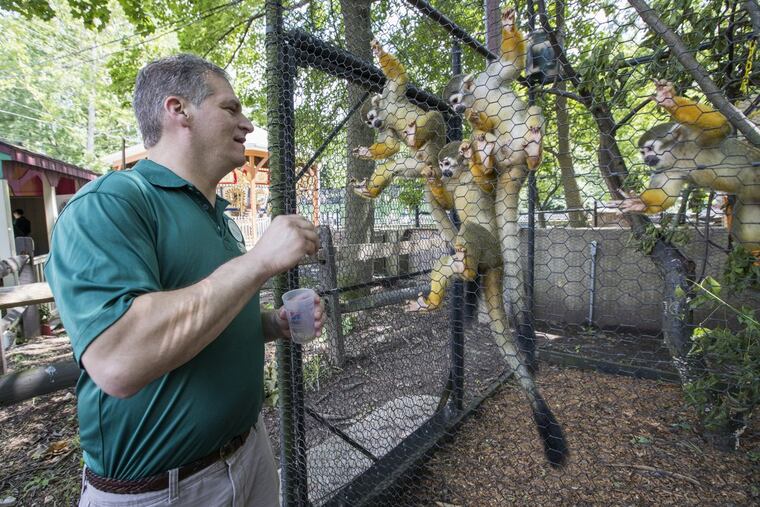When veterinarians and physicians collaborate, all kinds of patients benefit
In Philadelphia, the collaboration has been going on for more than a century.

Obstetrician Rebekah McCurdy agreed to provide assistance this summer to the Philadelphia Zoo if there were complications with the impending birth of an endangered gorilla.
"I was prepared," said McCurdy, who is with Thomas Jefferson University Hospital. But the odds of getting the call "were just so far out there."
On June 2, when the call came that Kira, a 17-year-old western lowland gorilla, might need a cesarean section, McCurdy dropped everything. The zoo veterinarians, who don't handle many gorilla births, wanted to be prepared, and McCurdy, with about 1,000 deliveries to her credit, had the experience they needed.
In Philadelphia, that collaboration has been going on for more than a century.
Whether dealing with newborn babies, broken teeth, diabetes, or cancer, veterinarians don't hesitate to consult dentists and medical doctors to get their patients the best possible care.
"We know that every [gorilla] infant is valuable, and we want to provide the best possible care," said Keith Hinshaw, Philadelphia Zoo's director of animal health. "Why not bring in an expert and have them help us out?"
Philadelphia is a premier location for the collaboration between veterinarians and medical doctors and dentists, said Barbara Natterson-Horowitz, a cardiologist and coauthor of Zoobiquity, a book that explores how the similarities between animals and humans can be used to diagnose and treat all species.
While those in veterinary medicine have often looked to other medical professionals for help, it is not part of the culture for human doctors, Natterson-Horowitz said.
"There is payoff to human health practitioners that comes from knowing about naturally occurring diseases that spontaneously occur in animals," she said, "from wild animals to pet cats, dogs, and birds."
Breast cancer is one example that occurs in both animals and humans, she said.
At the Elmwood Park Zoo in Norristown, veterinarian Adam G. Denish consulted both veterinary and medical oncologists when Joannie, a Chacoan peccary, was found to have mammary cancer.
The zoo needed to find appropriate medications that would work for a not-so-cooperative patient. Since the piglike mammals can be aggressive, injectable drugs were out of the question. And as most pets owners will attest, getting an animal to swallow pills can be a challenge. Joannie now gets her chemotherapy cocktail stuffed into chunks of banana or disguised with a peanut butter flavor.
"If we have a problem that is similar to a problem humans see, we consult human doctors," Denish said.
Dentists are often consulted, too.
Today, Ryan Veterinary Hospital of the University of Pennsylvania has a robust dental- and oral-surgery program, but that wasn't always the case.
In the 1970s, when there were not many veterinary dental specialists, Carl Tinkelman, an endodontist in Medford, volunteered to fix and clean teeth at the Philadelphia Zoo. He spent years reading up on animal dental health, working with veterinarians to change diet and oral health care, and occasionally fashioning his own instruments when those built for humans were not long or flexible enough.
He recalled that one time when he was in the process of performing a root canal on a gorilla, his patient "just sat right up." Tinkelman gently pushed him back down and gave him more drugs, he said.
He still volunteers to care for the zoo animals.
"There is nothing like the feeling of being next to a tiger or gorilla," Tinkelman said.
McCurdy knows that feeling well.
When she arrived at the Philadelphia Zoo in June, she found that first-time mother Kira was tired after a full night of labor, a possible signal for trouble because births in the wild are quick.
Once the ape was anesthetized, McCurdy found that she was fully dilated and that the baby's head was down like a human instead of up like in a normal gorilla delivery.
McCurdy determined that a vaginal delivery was still possible, but first they needed to fashion a pair of forceps out of medical retractors to use in the delivery.
"I reached in and pulled the baby out with those," said McCurdy.
After helping the zoo, McCurdy said she has a better appreciation for the wealth of resources she has on hand to treat her own patients — including equipment. And she enjoyed the collaboration as much as the delivery.
"Not everyone gets the safe delivery of a healthy baby," she said. "We were able to achieve that for the gorilla."
Sometimes, the partnership between veterinarians and human health practitioners is reversed.
This summer, it was Hinshaw who provided assistance for a human patient.
The Poison Control Center at Children's Hospital of Philadelphia was contacted by a suburban Philadelphia hospital after an adult was bitten by a Thai spitting cobra, said Kevin Osterhoudt, the center's medical director.
"Because it is not a native to the United States, no U.S. hospital would carry the venom," he said. Without the antidote, he said, the patient was at risk of death or severe tissue injury.
At 3 a.m., the center contacted Hinshaw, who got out of bed to retrieve an antidote that the zoo kept in its stockpile. The antivenin was delivered to the hospital within the window for successful treatment, Osterhoudt said.
That joint effort was an unusual example. More often, the Poison Control Center, which covers 23 counties in eastern Pennsylvania, teams up with veterinarians after a toddler or a depressed adult ingests medication meant for the family pet, Osterhoudt said.
Without the help of the veterinarians, he said, treating patients would be a lot more challenging.